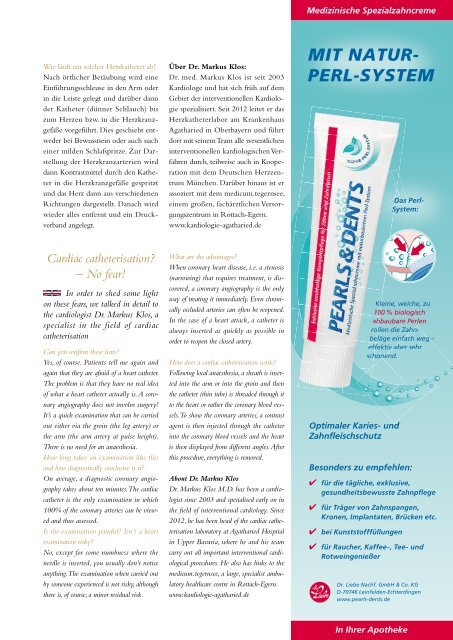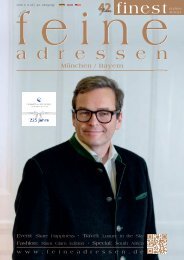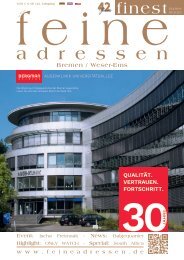Bremen 2 17
Event: Abschied Markus Poschner · Savoir Vivre: Ratskeller · Luxury: Inspirations · Top Marques Monaco · Living: Outdoor Special
Event: Abschied Markus Poschner · Savoir Vivre: Ratskeller · Luxury: Inspirations · Top Marques Monaco · Living: Outdoor Special
Erfolgreiche ePaper selbst erstellen
Machen Sie aus Ihren PDF Publikationen ein blätterbares Flipbook mit unserer einzigartigen Google optimierten e-Paper Software.
Medizinische Spezialzahncreme<br />
Wie läuft ein solcher Herzkatheter ab?<br />
Nach örtlicher Betäubung wird eine<br />
Einführungsschleuse in den Arm oder<br />
in die Leiste gelegt und darüber dann<br />
der Katheter (dünner Schlauch) bis<br />
zum Herzen bzw. in die Herzkranzgefäße<br />
vorgeführt. Dies geschieht entweder<br />
bei Bewusstsein oder auch nach<br />
einer milden Schlafspritze. Zur Darstellung<br />
der Herzkranzarterien wird<br />
dann Kontrastmittel durch den Katheter<br />
in die Herzkranzgefäße gespritzt<br />
und das Herz dann aus verschiedenen<br />
Richtungen dargestellt. Danach wird<br />
wieder alles entfernt und ein Druckverband<br />
angelegt.<br />
Über Dr. Markus Klos:<br />
Dr. med. Markus Klos ist seit 2003<br />
Kardiologe und hat sich früh auf dem<br />
Gebiet der interventionellen Kardiologie<br />
spezialisiert. Seit 2012 leitet er das<br />
Herzkatheterlabor am Krankenhaus<br />
Agatharied in Oberbayern und führt<br />
dort mit seinem Team alle wesentlichen<br />
interventionellen kardiologischen Verfahren<br />
durch, teilweise auch in Kooperation<br />
mit dem Deutschen Herzzentrum<br />
München. Darüber hinaus ist er<br />
assoziert mit dem medicum.tegernsee,<br />
einem großen, fachärztlichen Versorgungszentrum<br />
in Rottach-Egern.<br />
www.kardiologie-agatharied.de<br />
MIT NATUR-<br />
PERL-SYSTEM<br />
Das Perl-<br />
System:<br />
Cardiac catheterisation?<br />
– No fear!<br />
In order to shed some light<br />
on these fears, we talked in detail to<br />
the cardiologist Dr. Markus Klos, a<br />
specialist in the field of cardiac<br />
catheterisation<br />
Can you confirm these fears?<br />
Yes, of course. Patients tell me again and<br />
again that they are afraid of a heart catheter.<br />
The problem is that they have no real idea<br />
of what a heart catheter actually is. A coronary<br />
angiography does not involve surgery!<br />
It’s a quick examination that can be carried<br />
out either via the groin (the leg artery) or<br />
the arm (the arm artery at pulse height).<br />
There is no need for an anaesthesia.<br />
How long takes an examination like this<br />
and how diagnostically conclusive is it?<br />
On average, a diagnostic coronary angiography<br />
takes about ten minutes. The cardiac<br />
catheter is the only examination in which<br />
100% of the coronary arteries can be viewed<br />
and thus assessed.<br />
Is the examination painful? Isn’t a heart<br />
examination risky?<br />
No, except for some numbness where the<br />
needle is inserted, you usually don’t notice<br />
anything. The examination when carried out<br />
by someone experienced is not risky, although<br />
there is, of course, a minor residual risk.<br />
What are the advantages?<br />
When coronary heart disease, i.e. a stenosis<br />
(narrowing) that requires treatment, is discovered,<br />
a coronary angiography is the only<br />
way of treating it immediately. Even chronically<br />
occluded arteries can often be reopened.<br />
In the case of a heart attack, a catheter is<br />
always inserted as quickly as possible in<br />
order to reopen the closed artery.<br />
How does a cardiac catheterisation work?<br />
Following local anaesthesia, a sheath is inserted<br />
into the arm or into the groin and then<br />
the catheter (thin tube) is threaded through it<br />
to the heart or rather the coronary blood vessels.<br />
To show the coronary arteries, a contrast<br />
agent is then injected through the catheter<br />
into the coronary blood vessels and the heart<br />
is then displayed from different angles. After<br />
this procedure, everything is removed.<br />
About Dr. Markus Klos<br />
Dr. Markus Klos M.D. has been a cardiologist<br />
since 2003 and specialised early on in<br />
the field of interventional cardiology. Since<br />
2012, he has been head of the cardiac catheterisation<br />
laboratory at Agatharied Hospital<br />
in Upper Bavaria, where he and his team<br />
carry out all important interventional cardiological<br />
procedures. He also has links to the<br />
medicum.tegernsee, a large, specialist ambulatory<br />
healthcare centre in Rottach-Egern.<br />
www.kardiologie-agatharied.de<br />
Kleine, weiche, zu<br />
100 % biologisch<br />
abbaubare Perlen<br />
rollen die Zahnbeläge<br />
einfach weg –<br />
effektiv aber sehr<br />
schonend.<br />
Optimaler Karies- und<br />
Zahnfleischschutz<br />
Besonders zu empfehlen:<br />
✔ für die tägliche, exklusive,<br />
gesundheitsbewusste Zahnpflege<br />
✔ für Träger von Zahnspangen,<br />
Kronen, Implantaten, Brücken etc.<br />
✔ bei Kunststofffüllungen<br />
✔ für Raucher, Kaffee-, Tee- und<br />
Rotweingenießer<br />
Dr. Liebe Nachf. GmbH & Co. KG<br />
D-70746 Leinfelden-Echterdingen<br />
www.pearls-dents.de<br />
In Ihrer Apotheke


















